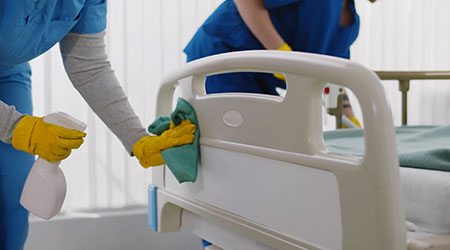It turns out Friedrich Nietzsche was right when he said, “That which does not kill us makes us stronger.” That saying is especially true when it comes to eliminating pathogens from touchpoints. For nearly 5,000 years, humans have concocted cleaning products. Yet the simple combination of soap and water remains one of the strongest weapons against infectious diseases, such as the coronavirus that causes COVID-19. Despite this, whenever there is an outbreak, people rush to the stores to buy chemical disinfectants, many of which are ineffective against more complex bacteria and viruses.
For the last two years, managers in healthcare facilities have focused on using products that eliminate the coronavirus from surfaces. While the main concern has been around a virus that can be inactivated with soap and water, superbugs such as Canadia auris (C-auris) and Methicillin-resistant Staphylococcus aureus (MRSA) have become more resistant to disinfectants. Now researchers are hoping to discover the mechanisms by which bacterium are developing high levels of resistance to certain disinfectants.
Tracking these mechanisms is becoming increasingly important, as disinfectants are one of the most viable protections against bacterial disease. Disinfectants could play an important role in managing bacterial infections in the future if the current trend of antibiotic resistance continues.
We must now question whether superbugs have gotten stronger in the last two years and why the failure to kill them on hard surfaces makes them stronger.
Here is just one of the failed cleaning and disinfecting practices that I believe are training superbugs to become stronger: quat binding.
When disinfectants are used at the correct dilution, quaternary amines compound (quats) are effective against bacteria and viruses. Now an important concern has been raised on whether it is effective to use cotton rags or disposable cellulose-based wipes, as the materials might release lower amounts of active quats than are indicated in an open bucket.
In contrast, it is also proposed that the closed-bucket system might maintain a higher active quaternary amine concentration than wipers made of cellulose and cotton used in the typical open-bucket system. The phenomenon of quat binding occurs when the active ingredient, quaternary ammonium chloride, becomes attracted to and absorbed into fabrics.
The science behind the way this happens is simple. Quats are positively charged ions, and cotton and other natural textiles are negatively charged. Positive attracts negative. The result is that at least a portion of the quat does not end up on the surface it is supposed to be disinfecting.
In fact, one study found that the quat level of a disinfectant remaining on a cotton cloth placed in a solution-filled pail decreased by 50 percent after soaking for just 10 minutes. That means the solution applied to the surface would contain only one-half of the parts per million listed on the label. Superbugs that are not eliminated can become resistant to the off-label application of disinfectants entirely.
J. Darrel Hicks, BA, MESRE, CHESP, Certificate of Mastery in Infection Prevention is the Past President of the Healthcare Surfaces Institute. Hicks is nationally recognized as a subject matter expert in infection prevention and control as it relates to cleaning. He is the owner/principal of Safe, Clean and Disinfected. His enterprise specializes in B2B consulting, webinar presentations, seminars and facility consulting services related to cleaning and disinfection. Learn more at www.darrelhicks.com.

 Building Sustainable Healthcare for an Aging Population
Building Sustainable Healthcare for an Aging Population Froedtert ThedaCare Announces Opening of ThedaCare Medical Center-Oshkosh
Froedtert ThedaCare Announces Opening of ThedaCare Medical Center-Oshkosh Touchmark Acquires The Hacienda at Georgetown Senior Living Facility
Touchmark Acquires The Hacienda at Georgetown Senior Living Facility Contaminants Under Foot: A Closer Look at Patient Room Floors
Contaminants Under Foot: A Closer Look at Patient Room Floors Power Outages Largely Driven by Extreme Weather Events
Power Outages Largely Driven by Extreme Weather Events